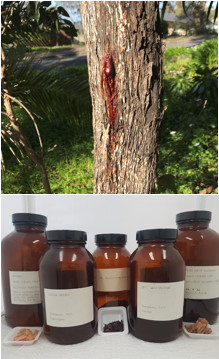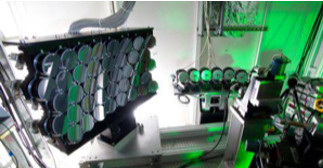
For thousands of years, Aboriginal Australians have utilized the extraordinary properties of certain plant exudates (resins, kinos and gums) for practical applications and cultural expression. Today, plant exudates continue to be incorporated in a variety of contemporary cultural contexts, such as hafting stone tools to handles, preparing paint binders or priming layers for bark paintings. In the early 20th century, a group of unknown naturalists assembled a large collection of plant exudates – most of which were collected between 1876 and 1905 – carefully annotating the provenance information. These samples have been stored up to the present in labeled brown glass jars, and the first documentation of the collection was in the laboratories at the Art Gallery of South Australia. In the late 1980s the collection was transferred and held in the South Australian state forensic laboratory until the early 2000s, before the collection was bequeathed to Flinders University by two former scientists with the intention for further research about this unique time capsule of samples (see Fig. 1). This collection provides a unique window into the composition of particularly well-preserved historical plant exudates, of cultural and technological interest.
A team of scientists from Australia, Belgium, France, Italy, and the US has used the penetrating power of hard x-rays at the Stanford Synchrotron Radiation Lightsource and the Synchrotron Soleil (France) to untangle the molecular composition of the plant materials in this collection [1]. Organic materials are rich in carbon and oxygen, elements that are conventionally studied with soft x-ray absorption near-edge structure (XANES) spectroscopy. However, the application of soft x-rays requires a very specialized sample environment and preparation, not suitable for the samples of this collection. The team therefore used a different approach that employs penetrating hard x-rays in a technique called x-ray Raman scattering (XRS). In XRS, instead of absorbing the x-rays, only a small fraction of their energy is transferred to the carbon and oxygen 1s core electrons. Thus, effectively a XANES spectrum is obtained, but by x-ray energy loss rather than x-ray absorption. The challenge with XRS is the fact that the signal is very weak, and that the detection requires a large array of analyzer crystals for measuring the inelastically scattered x-rays.

SSRL operates one of the world’s premier XRS instruments providing both high spectral resolution and a large solid angle for effective signal collection (see Fig. 2) [2]. Using XRS and complementing studies performed at synchrotron Soleil and at the University of Pisa, the team was able to determine the key chemical characteristics of these aged Australian plant exudates, relating them to each plant genus. Fig. 3 shows a series of carbon K-edge XRS spectra and their corresponding functional groups. As the chemical composition and material properties of exudates often determine their cultural use, it is not surprising that natural materials used over thousands of years of tradition continue to inspire their current and future uses. Combining XRS with other well-known techniques opens new avenues for characterizing and chemically classifying plant exudates, as well as studying their properties and function. This opens the exciting potential for identifying more of these organic compounds long used by Aboriginal Australian peoples and exploring their use and function in archaeological materials and cultural heritage objects.

R. Georgiou, R. S. Popelka-Filcoff, D. Sokaras, V. Beltran, I. Bonaduce, J. Spangler, S. X. Cohen, R. Lehmann, S. Bernard, J.-P. Rueff, U. Bergmann and L. Bertrand, "Disentangling the Chemistry of Australian Plant Exudates from a Unique Historical Collection", Proc. Natl. Acad. Sci. USA 119, e2116021119 (2022) doi: 10.1073/pnas.2116021119
D. Sokaras, D. Nordlund, T.-C. Weng, R. Alonso-Mori, P. Velikov, D. Wenger, A. Garachtchenko, M. George, V. Borzenets, B. Johnson, Q. Qian, T. Rabedeau and U. Bergmann, "A high resolution and large solid angle x-ray Raman spectroscopy end-station at the Stanford Synchrotron Radiation Lightsource", Rev. Sci. Instrum. 83, 43112 (2012) doi: 10.1063/1.4704458
R. Georgiou, R. S. Popelka-Filcoff, D. Sokaras, V. Beltran, I. Bonaduce, J. Spangler, S. X. Cohen, R. Lehmann, S. Bernard, J.-P. Rueff, U. Bergmann and L. Bertrand, "Disentangling the Chemistry of Australian Plant Exudates from a Unique Historical Collection", Proc. Natl. Acad. Sci. USA 119, e2116021119 (2022) doi: 10.1073/pnas.2116021119




